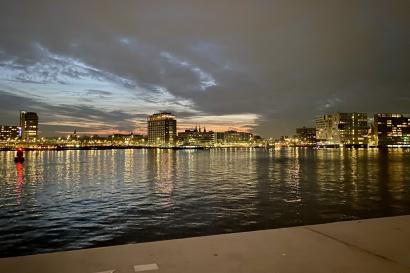It’s hard to leave Amsterdam once you’re there. Simply put, it is one of the best cities in the world. It is uniquely beautiful, easy to get around, an English speaker’s dream, safe and clean yet never dull. However, it is a very international city, and it can be easy to avoid assimilation and negate Dutch culture entirely. If you have no desire to get to know the culture of your host city, so be it. I think this is close-minded and will limit your experience, but to each their own. If, however, you are like me and strive to get to know the ins and outs of Dutch culture, then one of the most authentic and enriching things you can do is leave the city of Amsterdam.
The Dutch public transportation system is excellent; there are a plethora of cheap and accessible day trips. You can do your own research and select an appealing destination, but I had a very fulfilling experience visiting the beach town of Zandvoort just a few weeks ago. Dutch beaches are not glamorous. The water is the same color as the sky—gray—and it’s usually quite windy. The Dutch have embraced the wind, though; they practice what is called uitwaaien. This literally translates to “blowing out”, but this translation doesn’t really hold up. Uitwaaien is something like the therapeutic practice of walking in the wind; it is supposed to blow away your stress and anxieties, and ultimately be a calming, meditative practice. It doesn’t get more Dutch than framing a walk in the harsh wind as a form of therapy.
When I went to Zandvoort, it was, unsurprisingly, gray and windy. By the end of the day, I was sufficiently uitgewaaid (“blown out”). I went with two of my Dutch friends, who immediately took me to a food truck that only sold fish; we got kibbeling, which are battered fish chunks, and herring with pickles—delicious. We then walked along the beach for a while, relishing in the wind, before stopping at a beachside restaurant, where we were served cheap cappuccinos and a pizza by a disinterested Dutch teenager. From then, it was time to walk through the Waterleidingduinen—the water supply dunes. These ‘dunes’ have hardly any sand—they are largely wet woodlands that have served as the water extraction point for Amsterdam’s drinking water since 1853. The dunes are also a nature preserve teeming with wildlife, namely foxes and deer, or vossen en herten. We walked through the dunes for probably a total of two hours, exploring the open plains and sheltered woodlands, searching for wildlife. We sat on a log for a while with a fox sitting not more than 15 feet from us. We also saw probably 20 or 30 deer throughout the two hours. All the while the howling wind never let up—how peaceful!
At the end of the day, we were exhausted and hungry—that’s what walking head on into the wind will do to you, despite a stomach full of herring. We caught a bus back to Station Sloterdijk, where we then took the 22 back to the Houthavens. Then it was time for more snacks—kastengels, or cheese sticks, and bitterballen, which are breaded and fried balls of meat gravy—delectable. Overall, this was one of the most Dutch days I’ve ever had, and I’m better for it. It is so refreshing to step away from the international hustle of Amsterdam and experience what a typical day is for the majority of Dutch people, which entails exploring a small beach town, relishing in the gray and windy nature, and snacking on various fried delicacies. Dutch culture is peculiar and silly, and experiencing it firsthand through a daytrip to a place like Zandvoort is, simply put, very fun. Geniet ervan—enjoy it!

Kees Lynch
Despite being a history major and studying history at the UvA this year, I am a passionate musician. I have been playing piano for over a decade, focusing largely on jazz, but I love to play guitar, banjo, and mandolin in my free time!






